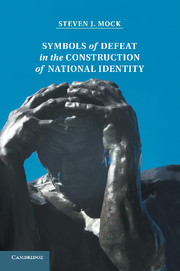Book contents
- Frontmatter
- Contents
- Acknowledgments
- Introduction
- 1 Theories of Nations and Nationalism
- 2 Totem Sacrifice and National Identity
- 3 Symbols of Defeat in National Monument and Ritual
- 4 The Defeat Narrative in National Myth and Symbol
- 5 Implications to Politics and Diplomacy
- 6 Exceptions
- Conclusions
- Bibliography
- Index
Introduction
Published online by Cambridge University Press: 05 January 2012
- Frontmatter
- Contents
- Acknowledgments
- Introduction
- 1 Theories of Nations and Nationalism
- 2 Totem Sacrifice and National Identity
- 3 Symbols of Defeat in National Monument and Ritual
- 4 The Defeat Narrative in National Myth and Symbol
- 5 Implications to Politics and Diplomacy
- 6 Exceptions
- Conclusions
- Bibliography
- Index
Summary
If the proverbial alien from outer space were to be placed, suddenly and unprepared, on the plaza overlooking the Western Wall in Jerusalem, what would he/she/it conclude about the prevailing political situation? One distinct ethnoreligious group would be seen beneath the wall, mourning their destruction and degradation against a meager ruin of what was clearly once a mighty structure. While above them, the location of what was, and indeed still is considered the holiest place in their religion was under the control of another ethnoreligious group, dominated by a glorious gold-plated dome enjoying its 14th century of existence on that spot. Which group would be presumed to be in control of the surrounding territory? Which would be presumed to have the larger army? Which would be presumed dominant, and which dominated?
Viewed in this light, the continued centrality of such a symbol to Israeli and Jewish national identity appears paradoxical. Indeed, one of the first acts of Israeli authorities upon conquering the site along with the whole of Jerusalem's Old City in the 1967 Six Day War was to raze 135 houses in the quarter immediately adjoining the Western Wall, summarily evicting its 650 inhabitants, so that a vast plaza could be constructed, comparable to the sort that a state might build to showcase a national cathedral or public building, so that Jews could mourn their powerlessness and degradation in larger numbers and relative comfort. There is little question that this remnant of the Second Temple complex, destroyed by the Romans during the Judean revolt in 70 c.e., remains Judaism's holiest site – arguably the only holy place universally recognized as such in the otherwise iconoclastic Jewish religion – as well as Israel's most important national symbol. The only site that has ever contested this latter designation is Masada, the location of the last battle of the Judean revolt against the Romans that ended in 73 c.e., which prior to 1967 had been adopted as secular Zionism's most significant and inspirational monument. A booklet titled “Facts About Israel,” published in English by the Israeli Ministry of Foreign Affairs, summarizes the Masada story as follows in a chapter titled “Roots”:
Nearly one thousand Jewish men, women and children who had survived the fall of Jerusalem refused to surrender to Rome. They took over King Herod's fortress on the steep rock-mountain of Masada by the Dead Sea. For three years they managed to hold their own against repeated Roman attempts to dislodge them. When the Romans finally broke through, they found that the Jews had committed suicide so as not to surrender to the enemy.
- Type
- Chapter
- Information
- Publisher: Cambridge University PressPrint publication year: 2011



